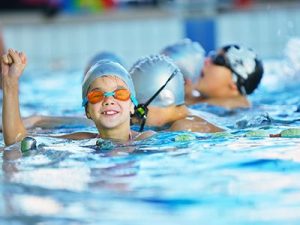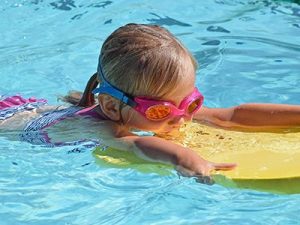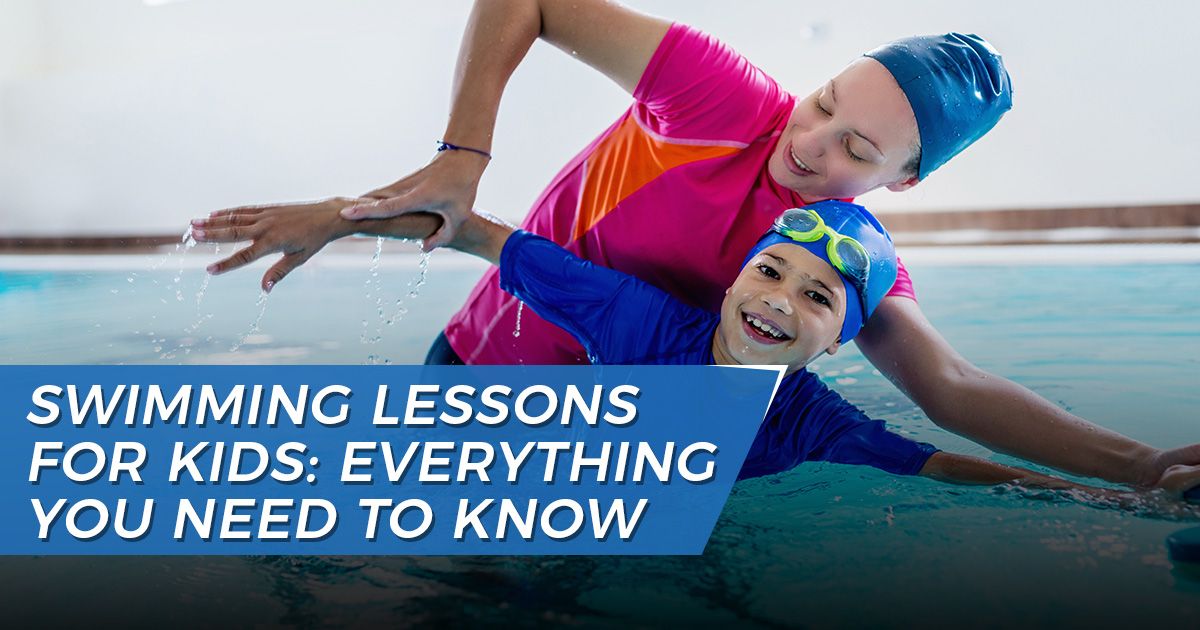Swimming Lessons For Kids: Everything You Need to Know
Even with safety precautions in place, accidents can happen, which is why swimming lessons for kids are so very important. Once summer rolls around and temperatures begin to rise, everyone wants to be outside. Splashing around in the water is what summer is all about. However, owning a pool comes with the responsibility of ensuring it’s safe for everyone who uses it. This includes installing fencing, alarms, and covers that prevent use or even alert you when someone has entered the water. But those things aren’t always enough, so it’s best to make sure everyone is comfortable, confident, and equipped for the best possible experience.
The Importance of Swim Lessons For Kids
 According to The Centers for Disease Control, drowning is the number one cause of accidental death for children between one and four years of age. While the possibility of drowning isn’t something parents like to think about, preparing children for accidental contact with water is one of the most important parental duties. This is particularly true for those with backyard pools, as an astounding 75% of drowning deaths involving children fifteen years old or younger occurred at swimming pools located in private residences. Given these staggering statistics, it’s clear that enrolling kids in swimming lessons is one of the best ways to protect them in the event that an accident does occur.
According to The Centers for Disease Control, drowning is the number one cause of accidental death for children between one and four years of age. While the possibility of drowning isn’t something parents like to think about, preparing children for accidental contact with water is one of the most important parental duties. This is particularly true for those with backyard pools, as an astounding 75% of drowning deaths involving children fifteen years old or younger occurred at swimming pools located in private residences. Given these staggering statistics, it’s clear that enrolling kids in swimming lessons is one of the best ways to protect them in the event that an accident does occur.
What Is the Best Age to Enroll Your Child?
 Although it’s widely accepted as a necessary safety precaution, not all children will be ready for lessons at the same age. Recently, the American Association of Pediatrics changed the youngest age at which children can safely be enrolled, from four years to one year old. This change is in response to a 2009 study that found an 88% reduction in drowning risk of children between one and four who had taken swim classes. However, some experts argue that enrolling infants in water survival programs can foster a false sense of security around water for parents. Therefore, it’s important to note that while children as young as one can learn to flip on their backs, they don’t have the cognitive capacity to learn water safety until around four years old.
Although it’s widely accepted as a necessary safety precaution, not all children will be ready for lessons at the same age. Recently, the American Association of Pediatrics changed the youngest age at which children can safely be enrolled, from four years to one year old. This change is in response to a 2009 study that found an 88% reduction in drowning risk of children between one and four who had taken swim classes. However, some experts argue that enrolling infants in water survival programs can foster a false sense of security around water for parents. Therefore, it’s important to note that while children as young as one can learn to flip on their backs, they don’t have the cognitive capacity to learn water safety until around four years old.
Experts suggest that parents should begin with parent-child instruction as early as three-months-old, to introduce their child to the water. This reduces their risk of developing water-related fears or anxiety, and ensures they are comfortable with the water once they are old enough swim independently. It’s important to note that regardless of the number of swim lessons your child has had, children typically don’t become truly competent swimmers until six or seven years old. Deciding at what age to enroll your child is a personal decision that will depend upon your child’s emotional and physical capacity, and your family’s proximity to water.
How to Choose the Best Swimming Lessons for Kids
Once you’ve determined the age at which your children will begin classes, it’s important to carefully select the class based on a number of important criteria. You may want to consider the following when selecting a program for your child:
- The program must have instructors who have been trained and certified through a nationally recognized program.
- The pool must have certified lifeguards on duty. Your child’s swim instructor should not also be acting as the lifeguard as their attention will be split amongst the class.
- The program should teach water safety habits beyond swimming. Children should be taught never to swim alone or without adult supervision. They should also be taught self-rescue techniques in the event that they unexpectedly find themselves in the water alone.
- They should allow you to watch a lesson before you enroll your child and should allow partial viewing once your child is enrolled.
- The program should include multiple sessions with gradual, but consistent, skill progression.
- The atmosphere should make your child feel safe and secure, especially for those under four years of age.
- The water should be warm and properly purified. For children three and younger, the water should be between 87-94 degrees Fahrenheit. The pool should have diaper requirements to prevent bodily fluids from entering the water and should be regularly purified as younger children tend to swallow water.
- The American Red Cross suggests that class sizes should be no more than ten students per instructor. However, with younger children or new instructors, the ratio should be even lower.
What is the Average Cost of Kids Swimming Lessons?
While costs can vary, the average cost in Florida is between $20 and $40. However, since there should be a number of classes (usually 8-10), you’ll likely end up paying anywhere between $160 and $400 for the full package.
Below, we’ve included a list of a few local swim schools for you to check out:
Highly Rated SwimKids USA
With two locations near Land O’ Lakes and Lutz, SwimKids USA is beloved by its students. They offer a wide variety of programs, so your child can continue to progress while remaining with the company. Whether you want to begin your child as an infant or have them master the breaststroke, there’s a class for them.
For that all important three to four year old range, your child will learn the techniques necessary to survive a typical drowning situation. And at four, they’ll be capable of doing so from 25 yards away, without anyone else in the pool. Many parents rave about the attentive staff who ensure that their children felt safe and comfortable during the lessons. This is imperative as kids can easily forget they’ve been taught when faced with adversity.
Seal Swim School Located in Lutz
An area oldie but a goodie, Seal Swim School began in 1952, when Therese Cullen Seal taught her first swim lesson. In 2005, they opened their first indoor location in Lutz, which was renovated just last year.
The swim school is a member of the United States Swim School Association and only employs instructors with CPR, First Aid, Water Safety Instructor, and Lifeguard Training certifications. They offer private and group sessions, and Camp Seal, which is designed to give your kids a chance to grow both in and out of the water. With field trips, sports, daily swim classes, and recreational swim opportunities, kids walk away well equipped for whatever situation they may find themselves in.
Private instruction with Mermaid Swim School
If you have your own pool, Mermaid Swim School is ideal for you. The instructors travel to you to teach your child to swim in the comfort of their own backyard. We couldn’t be more excited about this, as your own pool is where your child will spend most of their time.
Kids will learn safety in their surroundings, as well as in the water, which is perfect for nervous swimmers and shy children. Mermaid Swim School even has qualified staff to teach special needs students the proper techniques and safety precautions necessary. This sort of offering is invaluable for parents looking to equip their child with every tool out there. They operate in a number of Florida counties, including: Pasco, Pinellas, Hillsborough, Manatee, Sarasota, and Charlotte.
Choose What’s Best For Your Child
Clearly, there is a lot to consider when selecting the right swimming lessons for kids. You want to make sure they are comfortable, safe, and learning proper water safety techniques. Although deciding when your child is ready is up to you, it’s critical that children in homes with backyard pools become confident around the water as soon as possible. Teaching your child to swim is one of the best skills you can teach them and could even go as far as saving their life.
Along with prepping your family, you might also be considering what else is needed to get your pool ready for summer. Cleaning, maintenance, or even replacement of certain equipment might be on your radar this year. Remember, we’re here to help with everything you need to have the most fun – and safest – season yet.

